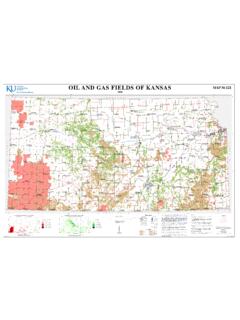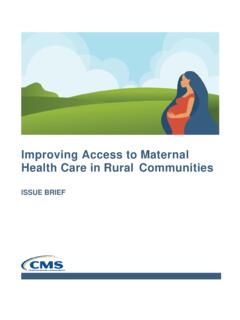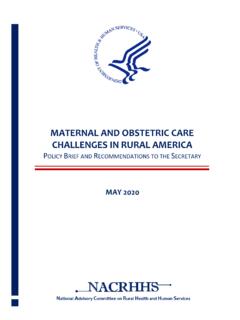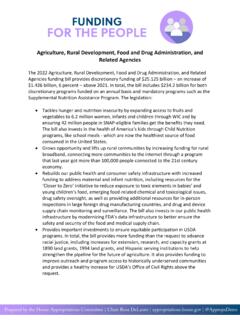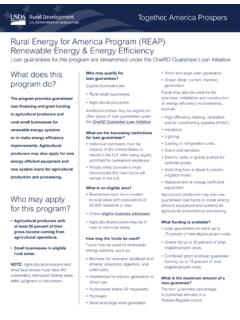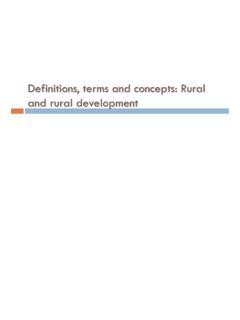Transcription of Capturing and Utilizing CO from Ethanol
1 Capturing and Utilizing CO2 from Ethanol :Adding Economic Value and Jobs to rural Economies and Communities While Reducing EmissionsWhite paper prepared by the State CO2-EOR Deployment Work GroupDecember 2017 Prepared by the State CO2-EOR Deployment Work GroupPage 2 Capturing and Utilizing CO2 from Ethanol :Adding Economic Value and Jobs to rural Economies and Communities While Reducing EmissionsAcknowledgementsThe final recommendations of this white paper represent the joint conclusions of state officials in the State CO2-EOR Deployment Work Group. However, participating state officials want to recognize the contributions of leading private sector stakeholders in CO2-enhanced oil recovery, carbon storage and Ethanol industry experts who lent their expertise and guidance to the effort. The state representatives extend their thanks to all who contributed to this white paper, and to the Hewlett Foundation and the MacArthur Foundation for the funding that made this work possible.
2 This white paper draws on research being conducted in collaboration with the Kansas Geological Survey as part of a DOE-funded CarbonSAFE by the State CO2-EOR Deployment Work GroupPage 3 Capturing and Utilizing CO2 from Ethanol :Adding Economic Value and Jobs to rural Economies and Communities While Reducing EmissionsState CO2-EOR Deployment Work Group Participant ListRepresentatives of Co-Convening Governors Matthew Fry, Senior Advisor, Office of Wyoming Governor Matt Mead Adam Schafer, Senior Advisor, Office of Montana Governor Steve BullockParticipating State Officials Stuart Ellsworth, Engineering Manager, Colorado Oil & Gas Conservation Commission Frank Farmer, Commission Counsel, Mississippi Public Service Commission Rolfe Mandel, Director, Kansas Geological Survey Patrick McDonnell, Secretary, Pennsylvania Department of Environmental Protection Paul Miller, Director, Technology Assessment Division, Louisiana Department of Natural Resources Leslie Savage, Chief Geologist, Railroad Commission of Texas Rob Simmons, Energy Policy & Law Manager, Utah Governor s Office of Energy Development Ted Thomas, Chairman, Arkansas Public Service Commission Steve Whittaker, Director.
3 Energy Research & Development, Illinois State Geological Survey Robert Worstall, Deputy Chief, Division of Oil & Gas Resources, Ohio Department of Natural Resources Tristan Vance, Director, Indiana Office of Energy DevelopmentParticipating Stakeholders & Experts Fatima Ahmad, Solutions Fellow, Center for Climate & Energy Solutions Jeff Brown, Lecturer in Management, Stanford University Graduate School of Business Steven Carpenter, Director, Enhanced Oil Recovery Institute, University of Wyoming Al Collins, Senior Director for Regulatory Affairs, Occidental Petroleum Corporation Ben Cook, Assistant Professor, Enhanced Oil Recovery Institute, University of Wyoming Martin Dubois, Geological Consultant, Improved Hydrocarbon Recovery, LLC. Sarah Forbes, Scientist, Office of Fossil Energy, Department of Energy Scott Hornafius, President, Elk Petroleum Rob Hurless, Deputy Director, Enhanced Oil Recovery Institute, University of Wyoming Dina Kruger, Principal, Kruger Environmental Strategies Steve Melzer, Geological Engineer and Principal, Melzer Consulting Deepika Nagabhushan, Policy Associate, Clean Air Task Force Todd O Hair, Senior Government Affairs Manager, Cloud Peak Energy John Thompson, Director, Fossil Transition Project, Clean Air Task Force Keith Tracy, President, Cornerpost CO2, LLCG reat Plains Institute Brad Crabtree, Vice President for Fossil Energy Anna Dirkswager, Program Manager Brendan Jordan, Vice President Patrice Lahlum, Program Consultant Dane McFarlane, Senior Research Analyst Doug Scott, Vice President for Strategic InitiativesPrepared by the State CO2-EOR Deployment Work GroupPage 4 Capturing and Utilizing CO2 from Ethanol .
4 Adding Economic Value and Jobs to rural Economies and Communities While Reducing EmissionsAbout the State CO2-EOR Deployment WorkgroupWyoming Governor Matt Mead (R) and Montana Governor Steve Bullock (D) jointly convened the State CO2-EOR Deployment Work Group in September 2015 as a key follow-on to the Western Governors Association resolution calling for federal incentives to accelerate the deployment of carbon capture from power plants and industrial facilities and increase the use of CO2 in enhanced oil recovery, while safely and permanently storing the CO2 underground in the process. The Great Plains Institute (GPI) provides coordination and staffing of Work Group states currently participate in the Work Group: Arkansas, Colorado, Illinois, Indiana, Kansas, Louisiana, Mississippi, Montana, Pennsylvania, Ohio, Texas, Utah and Wyoming. State participation varies by state and includes governors staff, cabinet secretaries, utility commissioners, and agency and commission staff.
5 Some state representatives participate at the direction of the governor; others do not. State representatives were joined by leading enhanced oil recovery, electric power, coal industry, regulatory and NGO Work Group identified three principal roles for its work, including modeling analysis and policy identification, developing recommendations for state and federal policy makers, and supporting the implementation of those policy recommendations. The CO2 EOR Work Group aims to foster: Expansion of CO2 capture from power plants and industrial facilities; Buildout of pipeline infrastructure to transport that CO2; and Use of CO2 in oil production, along with its safe and permanent Work Group released a comprehensive set of federal and state policy recommendations in December 2016 Putting the Puzzle Together: State & Federal Policy Drivers for Growing America s Carbon Capture & CO2-EOR Industry, a white paper outlining recommendations for national CO2 pipeline infrastructure in February 2017 - 21st Century Energy Infrastructure: Policy Recommendations for Development of American CO2 Pipeline Networks and a report recommending policies to enable power plants with carbon capture to compete cost-effectively in wholesale power markets entitled Electricity Market Design and Carbon Capture Technology: The Opportunities and the Challenges in June by the State CO2-EOR Deployment Work GroupPage 5 Capturing and Utilizing CO2 from Ethanol .
6 Adding Economic Value and Jobs to rural Economies and Communities While Reducing EmissionsTable of Contents6 Executive Summary9 Introduction11 CO2-EOR: Background and How It Works12 CO2-EOR & Ethanol : Opportunities & Challenges Explained13 Carbon Capture and Utilization: The Next Step in Adding Value to the Ethanol Industry16 Technical Evaluation of the Ethanol Opportunity20 Federal Policy Overview25 State & Provincial Low-Carbon Fuels Standards26 Conclusion27 Appendix: CO2 Pipeline Assumptions and Cost Model Acronym Guide45 QSection 45Q Tax Credit for Carbon Dioxide SequestrationARBC alifornia Air Resources BoardCapEXCapital expenditureCO2 Carbon dioxideDOED epartment of EnergyEORE nhanced oil recoveryIEAI nternational Energy AgencyLCFSLow carbon fuels standardMGYM illion gallons per yearMTMetric tonNETLN ational Energy Technology LaboratoryPABP rivate Activity BondOpEXOperating expenseQMQuantification methodology`Prepared by the State CO2-EOR Deployment Work GroupPage 6 Capturing and Utilizing CO2 from Ethanol :Adding Economic Value and Jobs to rural Economies and Communities While Reducing EmissionsExecutive SummaryAs the world leader in demonstrating carbon capture technologies in multiple industries, the is well-poised to expand commercial deployment and bring down the costs of CO2 capture, compression and pipeline transport.
7 With its high-purity and low-cost biogenic CO2 derived from Ethanol fermentation, the biofuels industry can play a key role in scaling up carbon management for energy production and geologic capture technology and the use and geologic storage of CO2 through enhanced oil recovery (CO2-EOR) have a successful history of commercial deployment going back nearly a half century. While roughly 80 percent of CO2 used in EOR is sourced from geologic domes, a commercial market for the sale of large volumes of captured CO2 from industrial facilities has existed for decades in the because the oil industry purchases it for injection into existing fields to recover additional crude. Storing CO2 in saline geologic formations a process that does not involve oil production is more recent, with the first commercial scale demonstration dating back to the this paper, the State CO2-EOR Deployment Work Group explores the opportunities for energy production, expanded economic development and emissions reduction potential from Capturing and Utilizing CO2 from Ethanol production.
8 The paper also describes the federal and state policies needed to foster further commercial deployment. The Work Group turns to this topic as a follow-up to its December 2016 report recommending federal and state carbon capture deployment incentives. These incentives are essential to enabling private investors to finance carbon capture at Ethanol facilities, power plants and other industrial facilities, as well as pipelines to transport the CO2 to oilfields and saline formations where it can be used and biofuels industry has a history of innovation to reduce energy and water use, drive down costs, generate new sources of revenue from value-added byproducts, and lower the carbon intensity of Ethanol . As it has improved energy efficiency and lowered emissions, the industry has sought new revenue opportunities from products that add value beyond the Ethanol itself. Fermentation in Ethanol production yields percent pure CO2, which can become an additional value stream; 1 in fact, the industry has sold biogenic CO2 to the EOR industry for nearly a deployment of carbon capture presents a significant economic opportunity for the Ethanol industry through the oil industry s purchase and beneficial use of CO2.
9 Proposed federal and state financial incentives and credits obtained by storing CO2 geologically through EOR or its injection into saline formations could provide additional economic value. Moreover, when the carbon accumulated in corn or other biomass feedstocks through photosynthesis is captured during fermentation, rather than released back to the atmosphere, even deeper reductions in lifecycle carbon emissions can be achieved. This, in turn, enhances the value of the Ethanol produced in key markets where public policy increasingly demands reductions in carbon lifecycle emissions reductions from the capture of biogenic CO2 from Ethanol fermentation can be The application of carbon capture to corn- Ethanol plants in the has the potential to reduce the carbon intensity of resulting biofuels production by upwards of 40 percent, if the captured CO2 is stored in saline geologic In the case of storing 1 While the CO2 stream from fermentation is of high purity, equipping an Ethanol plant for carbon capture requires investments in the fermenters for capture and in equipment to compress and dehydrate the CO2 prior to pipeline See Figure 1 for a timeline and description of carbon capture projects in the Ethanol Lindfeldt, Erik G.
10 , and Mats O. Westermark. 2008. System Study of Carbon Dioxide (CO2) Capture in Bio-Based Motor Fuel Production. Energy 33 (2):352 61. Laude, A., O. Ricci, G. Bureau, J. Royer-Adnot, and A. Fabbri. 2011. CO2 Capture and Storage from a Bioethanol Plant: Carbon and Energy Footprint and Economic Assessment. International Journal of Greenhouse Gas Control 5 (5):1220 31. McCoy, Sean T. 2017. The Value Proposition for Combining CCS and Ethanol Production. presented at the Capturing Value from Biogenic CO2: Opportunities for Ethanol and Other Industries, Johnston, Iowa, 2 August 2017. Ethanol industry already supplies roughly 270,000 MT of CO2 annually for EOR in Kansas and Texas, and ADM expects to inject up to million MT annually for saline storage in Illinois. For comparison, Occidental Petroleum, the world leader in CO2-EOR, injects 47 million MT of CO2 annually. The Ethanol industry has a strategic opportunity to deploy technology and infrastructure that would both increase its revenue and beneficially reduce carbon by the State CO2-EOR Deployment Work GroupPage 7 Capturing and Utilizing CO2 from Ethanol :Adding Economic Value and Jobs to rural Economies and Communities While Reducing Emissionscaptured CO2 in oilfields through EOR, large net emissions reductions still result, even after accounting for the additional oil produced.

